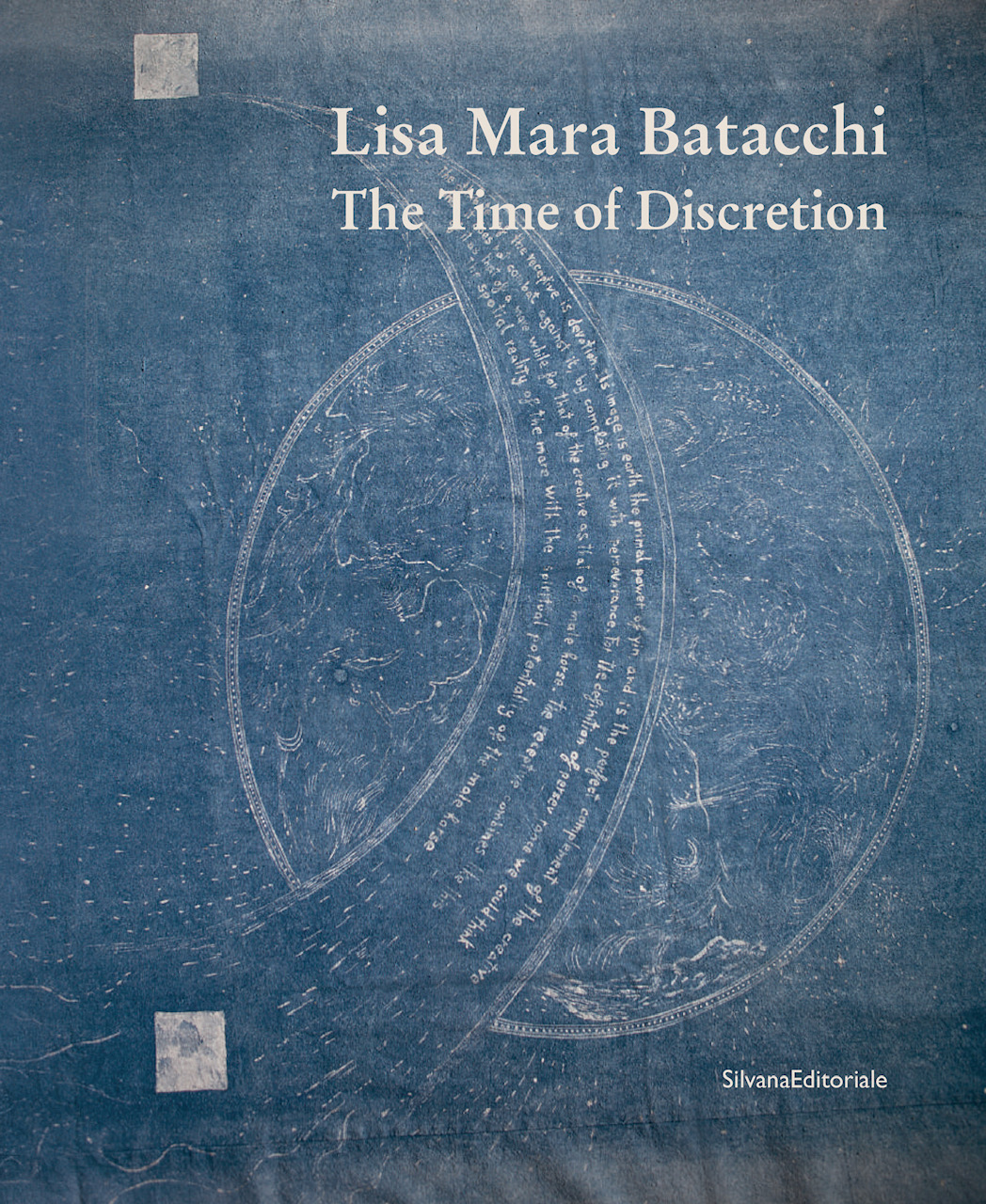Agorà
permanent sound installation
OPENArchival Platform
Lisa Batacchi
The time of Discretion è l’ultimo progetto a lungo termine dell’artista fiorentina Lisa Mara Batacchi, che presentò un capitolo del lavoro nella mostra omonima prodotta da MAD nel 2018 all'interno del ciclo Global Identities
Quest’anno con Silvana Editoriale esce la pubblicazione di tutto il progetto. La narrazione cronologica è cadenzata da immagini in presa diretta, opere e still dal film, che verranno in parte proiettati durante questa presentazione.
Sia la mostra che il libro sono stati curati da Veronica Caciolli.
Il progetto prende le mosse dalla partecipazione dell’artista alla Land Art Mongolia Biennal del 2016, il cui tema da declinare riguardava l’interpretazione dell’asse che divide il cielo dalla terra. Per farlo, l’artista ha raggiunto Guizhou, un villaggio montano della Cina meridionale dove l’antico popolo dei Hmong utilizza la tintura naturale ad indaco per realizzare tessuti tradizionali e celebrativi, oltre che per interrogare i propri avi. Dalla doppia esperienza con le donne Hmong, uniche custodi di questo processo, l’artista ha realizzato due tessuti: l’uno, trasportato in processione verso il monte sacro Altan Ovoo, ha costituito il lavoro per la Biennale
Quest’anno con Silvana Editoriale esce la pubblicazione di tutto il progetto. La narrazione cronologica è cadenzata da immagini in presa diretta, opere e still dal film, che verranno in parte proiettati durante questa presentazione.
Sia la mostra che il libro sono stati curati da Veronica Caciolli.
Il progetto prende le mosse dalla partecipazione dell’artista alla Land Art Mongolia Biennal del 2016, il cui tema da declinare riguardava l’interpretazione dell’asse che divide il cielo dalla terra. Per farlo, l’artista ha raggiunto Guizhou, un villaggio montano della Cina meridionale dove l’antico popolo dei Hmong utilizza la tintura naturale ad indaco per realizzare tessuti tradizionali e celebrativi, oltre che per interrogare i propri avi. Dalla doppia esperienza con le donne Hmong, uniche custodi di questo processo, l’artista ha realizzato due tessuti: l’uno, trasportato in processione verso il monte sacro Altan Ovoo, ha costituito il lavoro per la Biennale mongola. L’altro, l’immagine dell’odierna pubblicazione, rappresenta l’interpretazione di due esagrammi dell’I-Ching, interrogati sul destino imminente del mondo. Nel 2018 questi due lavori, assieme ad un video, due installazioni, cinque arazzi, quattro serie fotografiche e materiale documentario, hanno costituito la prima restituzione pubblica di questo ciclo di lavori, proprio alle Murate.
Il viaggio, l’esperienza e il lavoro di Lisa Mara Batacchi hanno offerto l’opportunità di affrontare una quanto mai interessante e puntuale serie di questioni: le reciproche interferenze o impermeabilità tra differenti culture, lo status di alcune minoranze etniche, gli esiti della globalizzazione, i ruoli della produzione industriale e manuale, le teorie sulla decrescita, la potenza o la miseria della memoria, il ruolo dell’arte. La complessità di questi temi, oltre che dalle due relatrici, è stata affrontata nel libro dalle molteplici prospettive di Sumesh Sharma, Federico Campagna, Valentina Gioia Levy, Wang Xiaomei.
This content is avaiable only in this archive.
The time of Discretion è l’ultimo progetto a lungo termine dell’artista fiorentina Lisa Mara Batacchi, che presentò un capitolo del lavoro nella mostra omonima prodotta da MAD nel 2018 all'interno del ciclo Global Identities

This content is avaiable only in this archive.
Global Identity
The time of Discretion. Chapter one di Lisa Batacchi, curated by Veronica Caciolli closes the cycle GLOBAL IDENTITIES. Postcolonial and cross-cultural Narratives curated by Valentina Gensini. The Time of Discretion is presented as a metaphorical and necessary retrospective on a cycle of works developed specifically on the subject of discretion and intended as its first chapter, over the last two years. The show consists of two works made in the south of China together with the Hmong people and about twenty new works expressly produced for this occasion, including installations, tapestries, videos, photographs, documentary archives and symbolic finds. The Time of Discretion is a transnational project in progress, which opens up complex and extremely sensitive issues that widely extend the boundaries of art. The exhibition intersects experience and representation, dramatically confronting the East and the West, advancing a dense theoretical scenario in relation to the processes of global
The time of Discretion. Chapter one di Lisa Batacchi, curated by Veronica Caciolli closes the cycle GLOBAL IDENTITIES. Postcolonial and cross-cultural Narratives curated by Valentina Gensini. The Time of Discretion is presented as a metaphorical and necessary retrospective on a cycle of works developed specifically on the subject of discretion and intended as its first chapter, over the last two years. The show consists of two works made in the south of China together with the Hmong people and about twenty new works expressly produced for this occasion, including installations, tapestries, videos, photographs, documentary archives and symbolic finds. The Time of Discretion is a transnational project in progress, which opens up complex and extremely sensitive issues that widely extend the boundaries of art. The exhibition intersects experience and representation, dramatically confronting the East and the West, advancing a dense theoretical scenario in relation to the processes of globalization. The project begins with the participation of Lisa Batacchi at the Land Art Mongolia Biennal of 2016, whose theme to be discussed concerned the interpretation of the axis that divides the sky from the earth. To do so, the artist reached Guizhou, a mountain village in southern China where the ancient Hmong people (originating from the Siberian-Mongol area), observe a traditional ritual daily. In particular, they hold a specific practice, considered divinatory, that of natural indigo dyeing. A large tent created by the artist, manually, slowly and discretely, together with the Hmong women, was later carried in a procession towards the sacred mountain Altan Ovoo, for the inaugural performance of the Biennale. The horse-cow represented there, shows a symbology derived from a Chinese oracle of the classical tradition, questioned preliminarily by the artist, whose sentences are governed by a logic of randomness, through the repeated tossing of coins. A randomness clearly understood as not accidental but secretly determined, also deliberately regulates the progressive behavior of Lisa Batacchi. A subsequent experience with this people allowed her to dye another fabric, which still draws on the meanings expressed in the fortieth and in the second hexagram of the I-Ching (The liberation – The receptive). Alongside these, there are further twenty multimedia works, produced for this exhibition and shown in preview for the Le Murate space. The collaboration with different types of mastery, activity that characterizes one of the directions of the project, has been extended by the artist to the local area, first in the city of Florence, where through the ancient looms of the Lisio Foundation, she has been able to realize five fabric tapestries. A toli, an amulet usually worn and used by Mongolian shamans, has instead been reproduced on a large scale, for performative as well as exhibition purposes, in parternship with the la Scuola Superiore Sant’Anna di Pisa. A new batik dyed with guado (ancient vegetable color) will be realized during the summer together with Natural Color Culture in the Marche region and premiered at Le Murate on September the 4th. The exhibition is also enriched by four photographic series that on one hand document the performance for the Land Art Mongolia Biennal, the backstage material of this first chapter and a collection that represents the beauty, the persistence of tradition and the fragility of a world partially isolated, on the threshold of globalization but still magically possible. Eventually, a video, which anticipates an upcoming feature film, retraces the landscape, relational and cultural stages of Mongolia, Inner Mongolia and southern China, in which poetry, imagery and narration become confused. June 7th h 5.30 p.m. introduction to exhibition by Veronica Caciolli curator, Valentina Gensini artistic director Le murate. Progetti Arte Contemporanea and the artist Lisa Batacchi h 6.30 p.m. vernissage
In particular, they hold a specific practice, considered divinatory, that of natural indigo dyeing. A large tent created by the artist, manually, slowly and discretely, together with the Hmong women, was later carried in a procession towards the sacred mountain Altan Ovoo, for the inaugural performance of the Biennale.
The horse-cow represented there, shows a symbology derived from a Chinese oracle of the classical tradition, questioned preliminarily by the artist, whose sentences are governed by a logic of randomness, through the repeated tossing of coins. A randomness clearly understood as not accidental but secretly determined, also deliberately regulates the progressive behavior of Lisa Batacchi.
A subsequent experience with this people allowed her to dye another fabric, which still draws on the meanings expressed in the fortieth and in the second hexagram of the I-Ching (The liberation – The receptive).
Alongside these, there are further twenty multimedia works, produced for this exhibition and shown in preview for the Le Murate space.
The collaboration with different types of mastery, activity that characterizes one of the directions of the project, has been extended by the artist to the local area, first in the city of Florence, where through the ancient looms of the Lisio Foundation, she has been able to realize five fabric tapestries.
A toli, an amulet usually worn and used by Mongolian shamans, has instead been reproduced on a large scale, for performative as well as exhibition purposes, in parternship with the la Scuola Superiore Sant’Anna di Pisa.
A new batik dyed with guado (ancient vegetable color) will be realized during the summer together with Natural Color Culture in the Marche region and premiered at Le Murate on September the 4th.
The exhibition is also enriched by four photographic series that on one hand document the performance for the Land Art Mongolia Biennal, the backstage material of this first chapter and a collection that represents the beauty, the persistence of tradition and the fragility of a world partially isolated, on the threshold of globalization but still magically possible.
Eventually, a video, which anticipates an upcoming feature film, retraces the landscape, relational and cultural stages of Mongolia, Inner Mongolia and southern China, in which poetry, imagery and narration become confused.
Il progetto nell’ambito di ToscanaInContemporanea 2018
This content is avaiable only in this archive.

Artista visiva
Lisa Mara Batacchi si forma al Polimoda di Firenze con una lurea in fashion design lavorando in seguito per vari marchi di alta moda, in particolare per Vivienne Westwood a Londra. Successivamente consegue una laurea in Arti Visive presso l’Accademia di Belle Arti di Firenze. Le sue opere sono state esposte in numerose mostre personali e collettive, fra cui ricordiamo: 2°Something Else Cairo Biennale, Murate Art District (personale) a Firenze, Manifesta12 evento collaterale a Palermo, Art & Globalization Pavillion durante la 57a Biennale di Venezia, Dust space gallery a Milano, 4°Land Art Mongolia Biennale a Ulan Bator, Textile Arts Center a New York, Villa Ada a Roma, Clark House Initiative (personale) a Bombay, Villa Pacchiani a Pisa, riss (e) Zentrum (personale) a Varese, Mac, n a Pistoia. È vincitrice, tra gli altri, del premio italiano Movin’up per giovani artisti italiani all’estero. Negli ultimi anni ha tenuto laboratori e collaborato a progetti educativ
Lisa Mara Batacchi si forma al Polimoda di Firenze con una lurea in fashion design lavorando in seguito per vari marchi di alta moda, in particolare per Vivienne Westwood a Londra. Successivamente consegue una laurea in Arti Visive presso l’Accademia di Belle Arti di Firenze. Le sue opere sono state esposte in numerose mostre personali e collettive, fra cui ricordiamo: 2°Something Else Cairo Biennale, Murate Art District (personale) a Firenze, Manifesta12 evento collaterale a Palermo, Art & Globalization Pavillion durante la 57a Biennale di Venezia, Dust space gallery a Milano, 4°Land Art Mongolia Biennale a Ulan Bator, Textile Arts Center a New York, Villa Ada a Roma, Clark House Initiative (personale) a Bombay, Villa Pacchiani a Pisa, riss (e) Zentrum (personale) a Varese, Mac, n a Pistoia. È vincitrice, tra gli altri, del premio italiano Movin’up per giovani artisti italiani all’estero. Negli ultimi anni ha tenuto laboratori e collaborato a progetti educativi con Palazzo Strozzi a Firenze, con ACAF Foundation a Shanghai, con Siena Art Institute, con Lottozero a Prato.
This content is avaiable only in this archive.